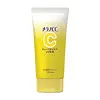Melano CC Vitamin C Brightening Lotion Milk Versus Melano CC Vitamin C Deep Day Care UV Lotion SPF 50+ PA++++
What's inside
What's inside
 Key Ingredients
Key Ingredients

 Benefits
Benefits

 Concerns
Concerns

 Ingredients Side-by-side
Ingredients Side-by-side

Dipotassium Glycyrrhizate
HumectantAscorbic Acid
AntioxidantHydrolyzed Grape Fruit Extract
HumectantCitrus Limon Fruit Extract
MaskingAlpinia Katsumadai Seed Extract
Skin ConditioningButylene Glycol
HumectantGlycerin
HumectantDipropylene Glycol
HumectantXanthan Gum
EmulsifyingParfum
MaskingPolyglyceryl-3 Decyltetradecyl Ether
EmulsifyingMethylglucoside Phosphate
Skin ConditioningPCA Dimethicone
Skin ConditioningEDTA
Methyl/Phenyl Polysilsesquioxane
Sodium Paraben
Preservative3-O-Ethyl Ascorbic Acid
Skin ConditioningAlcohol Denat.
AntimicrobialCitric Acid
BufferingDimethicone
EmollientSodium Citrate
BufferingStearoxymethicone/Dimethicone Copolymer
Emollient1,4-Cyclohexanedicarboxylic Acid
L-Menthanone
PerfumingAlcohol
AntimicrobialDipotassium Glycyrrhizate, Ascorbic Acid, Hydrolyzed Grape Fruit Extract, Citrus Limon Fruit Extract, Alpinia Katsumadai Seed Extract, Butylene Glycol, Glycerin, Dipropylene Glycol, Xanthan Gum, Parfum, Polyglyceryl-3 Decyltetradecyl Ether, Methylglucoside Phosphate, PCA Dimethicone, EDTA, Methyl/Phenyl Polysilsesquioxane, Sodium Paraben, 3-O-Ethyl Ascorbic Acid, Alcohol Denat., Citric Acid, Dimethicone, Sodium Citrate, Stearoxymethicone/Dimethicone Copolymer, 1,4-Cyclohexanedicarboxylic Acid, L-Menthanone, Alcohol
Water
Skin ConditioningAlcohol Denat.
AntimicrobialEthylhexyl Methoxycinnamate
UV AbsorberButylene Glycol
HumectantTriethylhexanoin
MaskingTitanium Dioxide
Cosmetic ColorantDiethylamino Hydroxybenzoyl Hexyl Benzoate
UV FilterAscorbyl Glucoside
AntioxidantMagnesium Ascorbyl Phosphate
AntioxidantTocopheryl Acetate
AntioxidantSodium Hyaluronate
HumectantPassiflora Alata Fruit Extract
Methylene Bis-Benzotriazolyl Tetramethylbutylphenol
UV FilterGlycol Dimethacrylate Crosspolymer
Bis-Ethylhexyloxyphenol Methoxyphenyl Triazine
Skin ConditioningPEG-40 Stearate
EmulsifyingPolysilicone-13
Acrylates/C10-30 Alkyl Acrylate Crosspolymer
Emulsion StabilisingMelaleuca Alternifolia Leaf Oil
AntioxidantAmmonium Acryloyldimethyltaurate/Vp Copolymer
Silica
AbrasivePolystyrene
Polyvinyl Alcohol
Disodium EDTA
Decyl Glucoside
CleansingXanthan Gum
EmulsifyingAlumina
AbrasivePropylene Glycol
HumectantSynthetic Fluorphlogopite
Tin Oxide
AbrasiveParfum
MaskingWater, Alcohol Denat., Ethylhexyl Methoxycinnamate, Butylene Glycol, Triethylhexanoin, Titanium Dioxide, Diethylamino Hydroxybenzoyl Hexyl Benzoate, Ascorbyl Glucoside, Magnesium Ascorbyl Phosphate, Tocopheryl Acetate, Sodium Hyaluronate, Passiflora Alata Fruit Extract, Methylene Bis-Benzotriazolyl Tetramethylbutylphenol, Glycol Dimethacrylate Crosspolymer, Bis-Ethylhexyloxyphenol Methoxyphenyl Triazine, PEG-40 Stearate, Polysilicone-13, Acrylates/C10-30 Alkyl Acrylate Crosspolymer, Melaleuca Alternifolia Leaf Oil, Ammonium Acryloyldimethyltaurate/Vp Copolymer, Silica, Polystyrene, Polyvinyl Alcohol, Disodium EDTA, Decyl Glucoside, Xanthan Gum, Alumina, Propylene Glycol, Synthetic Fluorphlogopite, Tin Oxide, Parfum
 Reviews
Reviews

Ingredients Explained
These ingredients are found in both products.
Ingredients higher up in an ingredient list are typically present in a larger amount.
Alcohol Denat. is an alcohol with a denaturant property. It is created by mixing ethanol with other additives.
This ingredient gets a bad rep because it is irritating and drying - mostly due to its astringent property. Astringents draw out natural oils in tissue, constricting pores and leaving your skin dried out.
However, alcohol denat. is not all that bad.
Due to its low molecular weight, alcohol denat. tends to evaporate quickly. One study on pig skin found half of applied alcohol evaporated in 10 seconds and less than 3% stayed on skin.
This also helps other ingredients become better absorbed upon application.
Studies are conflicted about whether this ingredient causes skin dehydration. One study from 2005 found adding emollients to propanol-based sanitizer decreased skin dryness and irritation. Another study found irritation only occurs if your skin is already damaged.
Small amounts of alcohol are generally tolerated by oily skin or people who live in humid environments.
The rule of thumb is if this alcohol is near the end of an ingredients list, it will probably not affect your skin much.
Also...
This ingredient has antimicrobial and solvent properties.
The antimicrobial property helps preserve products and increase their shelf life. As a solvent, it helps dissolve other ingredients.
Other types of astringent alcohols include:
Learn more about Alcohol Denat.Butylene Glycol (or BG) is used within cosmetic products for a few different reasons:
Overall, Butylene Glycol is a safe and well-rounded ingredient that works well with other ingredients.
Though this ingredient works well with most skin types, some people with sensitive skin may experience a reaction such as allergic rashes, closed comedones, or itchiness.
Learn more about Butylene GlycolParfum is a catch-all term for an ingredient or more that is used to give a scent to products.
Also called "fragrance", this ingredient can be a blend of hundreds of chemicals or plant oils. This means every product with "fragrance" or "parfum" in the ingredients list is a different mixture.
For instance, Habanolide is a proprietary trade name for a specific aroma chemical. When used as a fragrance ingredient in cosmetics, most aroma chemicals fall under the broad labeling category of “FRAGRANCE” or “PARFUM” according to EU and US regulations.
The term 'parfum' or 'fragrance' is not regulated in many countries. In many cases, it is up to the brand to define this term.
For instance, many brands choose to label themselves as "fragrance-free" because they are not using synthetic fragrances. However, their products may still contain ingredients such as essential oils that are considered a fragrance by INCI standards.
One example is Calendula flower extract. Calendula is an essential oil that still imparts a scent or 'fragrance'.
Depending on the blend, the ingredients in the mixture can cause allergies and sensitivities on the skin. Some ingredients that are known EU allergens include linalool and citronellol.
Parfum can also be used to mask or cover an unpleasant scent.
The bottom line is: not all fragrances/parfum/ingredients are created equally. If you are worried about fragrances, we recommend taking a closer look at an ingredient. And of course, we always recommend speaking with a professional.
Learn more about ParfumXanthan gum is used as a stabilizer and thickener within cosmetic products. It helps give products a sticky, thick feeling - preventing them from being too runny.
On the technical side of things, xanthan gum is a polysaccharide - a combination consisting of multiple sugar molecules bonded together.
Xanthan gum is a pretty common and great ingredient. It is a natural, non-toxic, non-irritating ingredient that is also commonly used in food products.
Learn more about Xanthan Gum